BEST Traditional Mincemeat
This post may contain affiliate links. See my disclosure policy.
If you’ve never cared for the store-bought stuff or even most homemade versions, you’re not alone. But just wait until you’ve tried this genuinely authentic, old-fashioned homemade mincemeat – it’s a total game-changer! Whether you’ve never liked mincemeat or you’ve always loved it, prepare to either be converted or to fall even more deeply in love! With this authentic mincemeat recipe in hand you’ll be able to make the most scrumptious homemade Mince Pies!
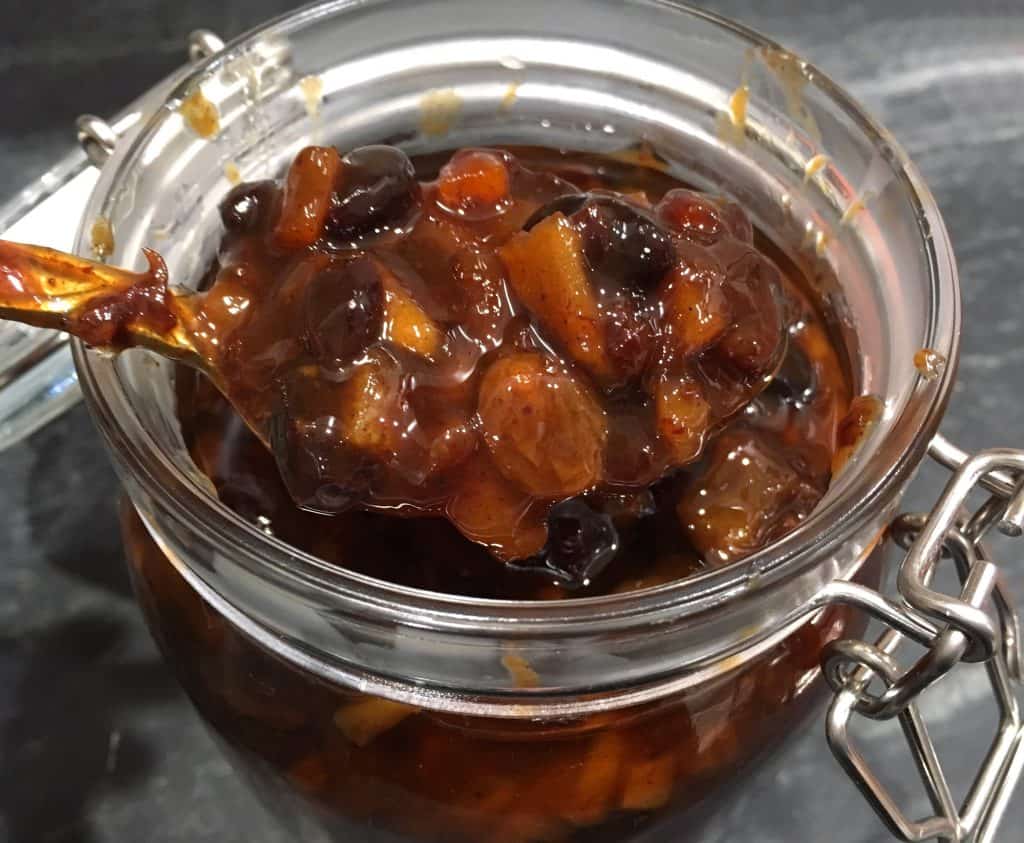
Few people today know the taste of true, authentic mincemeat, a dish dating back to the 11th century. And that explains why very few people I know actually truly enjoy mincemeat versus simply eating it out of tradition (or being forced to so as not to offend Grandma!). Sadly the authentic way of making mincemeat has been largely lost in the last century.
Whatever Happened to Traditional Mincemeat?
And I say lost, not because it’s been erased completely, rather because mincemeat has changed so much, some of its most important elements having been left out, that it just barely resembles its original ancestor. Of the many traditional British dishes that have undergone some form of alteration over the years, mincemeat has probably changed the most. That is largely due to the common omission of mincemeat’s two key ingredients: Meat (traditionally beef or lamb) and suet.
Things like wartime rations on meat, British culinary tastes moving away from sweet-savory combinations, and shifting trends away from the traditional use of suet (read my article on why you should use suet and lard – in short, medical research confirms our ancestors were right after all!) contributed to the gradual moving away from the inclusion of meat and suet in mincemeat. The result of these changes is manifest in the tiny mince pies of today that are almost sickly sweet without the savory meat and suet to round out the flavors and also fairly flat and one-dimensional in flavor profile without the complexity of the savory ingredients. This beloved dish of both the common folk and royalty (savored by generations of kings who enjoyed mince pies during their coronations and at their stately tables) sadly has been reduced to something that is a mere vestige, a residue, of what it once was – the spirits of centuries ago hover over what is passed off today as mincemeat while clenching their fists and wailing in agony.
Okay, that’s a little dramatic.
Essential Ingredients
Many generations ago people would experience mincemeat as a robust and sweet-savory meat-based mixture that conjured up what seemed like a thousand flavor sensations. Pair that with the incomparable texture that suet contributes to pie crust as it’s baked with the mincemeat and it’s no wonder that mincemeat pie was a heralded favorite for many centuries in the United Kingdom and then made its way to become a tradition in Canada, Australia, New Zealand, Ireland, Northern Europe, South Africa, and the New England region of the U.S..
Mince pies are still considered an essential accompaniment to holiday dinners today. But to be truly “traditional”, mincemeat requires meat and suet.

A note about SUGAR: Centuries ago mincemeat was far less sweet than it is today. Though it was made with fruits to add sweetness and to help preserve it (the fructose content), no sugar was added. Feel free to cut back on the brown sugar if you prefer.
A note about MEAT: If you’re put off at the thought of adding meat to mincemeat like our ancestors did for centuries, think of it this way: Imagine a Moroccan tagine – a dish of beef or lamb that is slow cooked with dried fruit, nuts and a myriad of aromatic spices. It’s downright amazing. Mincemeat, which not surprisingly originates from the Crusaders bringing the spices and method back with them from the Middle East, is a very similar concept: Beef that is simmered with dried fruits, nuts and a wonderful host of spices. That doesn’t sound so bad, does it? The mincemeat is stored for a while (under a layer of fat, a centuries-old method of preservation) so the flavors can deepen, and then it’s baked in a flaky pie. Heaven.
Why Make Your Own Candied Citrus Peel?
Another aspect that has always been off-putting to me about mincemeat is the overpowering flavor of the commercial candied citrus peel that’s called for in most recipes. It has a strong chemical-astringent flavor that many people dislike. For that reason I use and highly recommend making your own homemade candied orange peel for this mincemeat. Trust me, the flavor is incomparable and puts the store-bought stuff to miserable shame. And good candied citrus peel gives mincemeat an incredible flavor boost. That said, if you don’t mind store-bought candied citrus peel and want to save yourself the effort, feel free to use it. (Also, while not traditional, you can also include some Candied Ginger if you like.)
Check out my post on how to make Candied Orange Peel.

Why Use Suet?
While you “can” substitute butter (and even coconut oil, though that will greatly alter the flavor), I highly recommend suet for both flavor and texture, especially if you’re making mince pies. If you’ve ever made pie crust with suet you’ll understand – the end result is flaky and flavorful perfection unlike anything else. When you’re baking your mince pies the suet will bake into the pie crust enhancing texture and flavor.
I usually make my own suet when I have access to some kidney fat from locally-raised, grass-fed cows. Check out my tutorial on How to Make Beef Tallow. It’s super easy to make yourself. For a store-bought option I recommend Atora Shredded Beef Suet from England and a household name since 1893, but it’s usually extremely expensive to buy outside the UK.
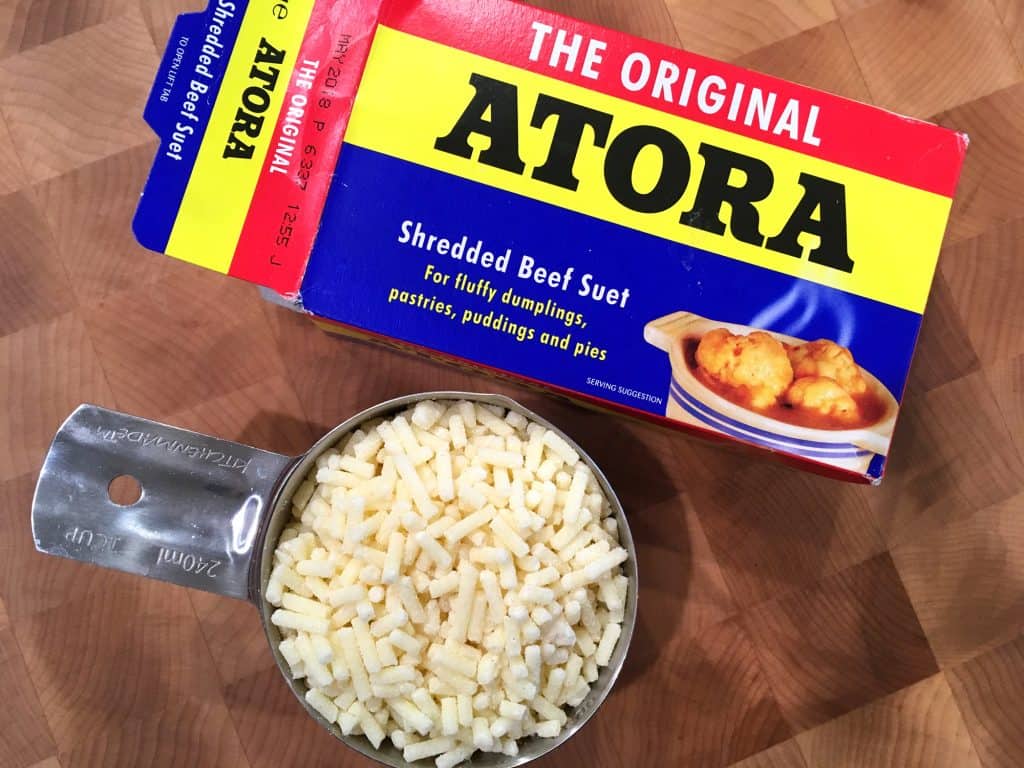
How to Can Mincemeat
A note about PRESERVING: Traditionally mincemeat would be made the year before it’s eaten to give the flavors time do develop and deepen. While time does improve it, it is delicious eaten within just a few days. However, if you want to store it there are several options:
Refrigerator: If you omit the meat it will last for up to a year in clean sterilized jars (some keep it several years in the back of the fridge). The layer of fat on top seals off the mincemeat from any air which results in food deterioration. This is a method of preserving that’s been used for many centuries. If you include the meat it will safely last in your fridge for up to 2 weeks.
Freezer: Either with or without meat, mincemeat can be frozen in airtight containers or in ziplock bags for up to 6 months.
Canning for long-term storage: If you want the traditional meat version to keep longer you can process the quart-sized (or pint-sized) mason jars (leaving 1 inch headspace) in a pressure canner (not a water bath). Spoon the hot mincemeat into sterilized quart or pint mason jars leaving 1 inch headspace. Use a clean moist rag to wipe off any oil from the jars. Seal and process in a pressure canner according to the time and pressure outlined in the chart below and the mincemeat will keep for up to a year:
| Recommended process time for a dial-gauge pressure canner. | ||||||
| Canner Pressure (PSI) at Altitudes of | ||||||
| Style of Pack | Jar Size | Process Time | 0 – 2,000 ft | 2,001 – 4,000 ft | 4,001 – 6,000 ft | 6,000 – 8,000 ft |
| Hot | Quarts | 90 min | 11 lb | 12 lb | 13 lb | 14 lb |
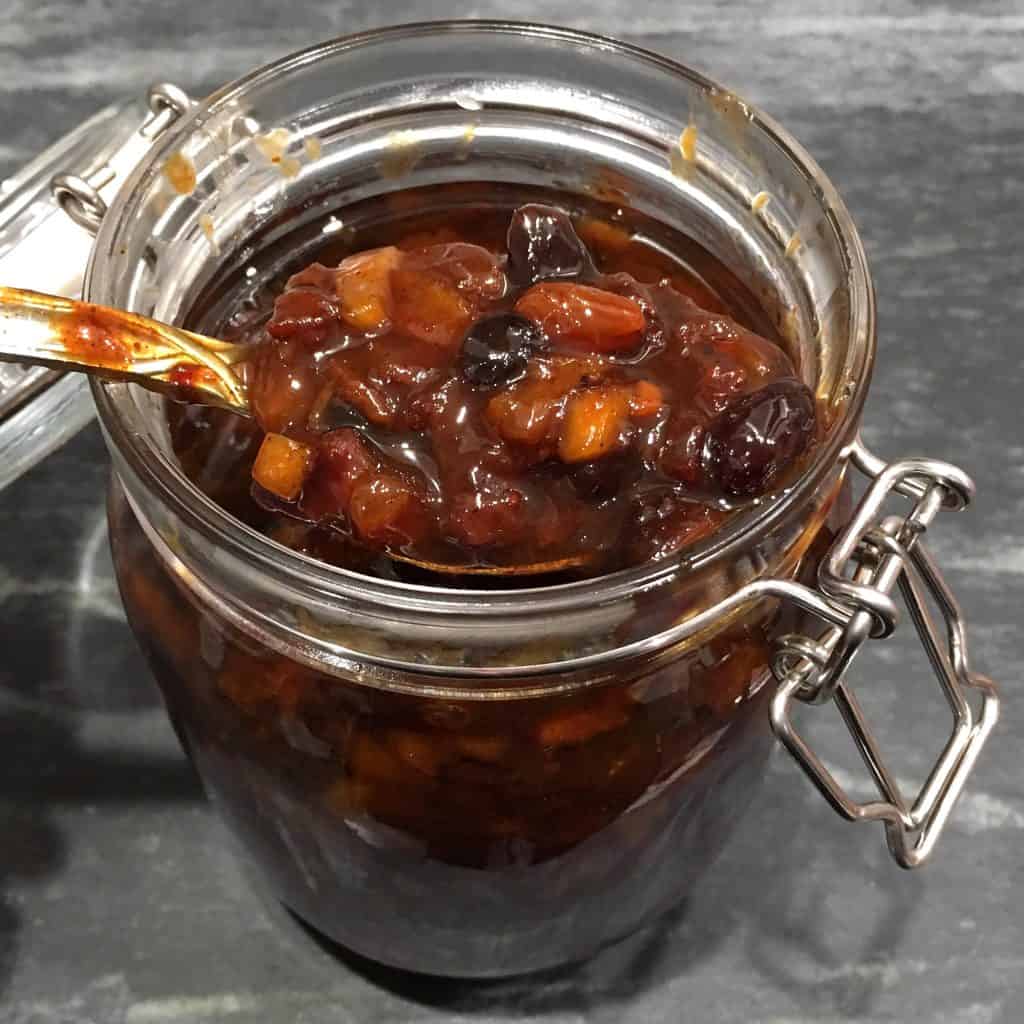
Mincemeat Recipe
Let’s get started!
Combine all of the ingredients, except for the brandy and/or rum in a medium-sized pot.
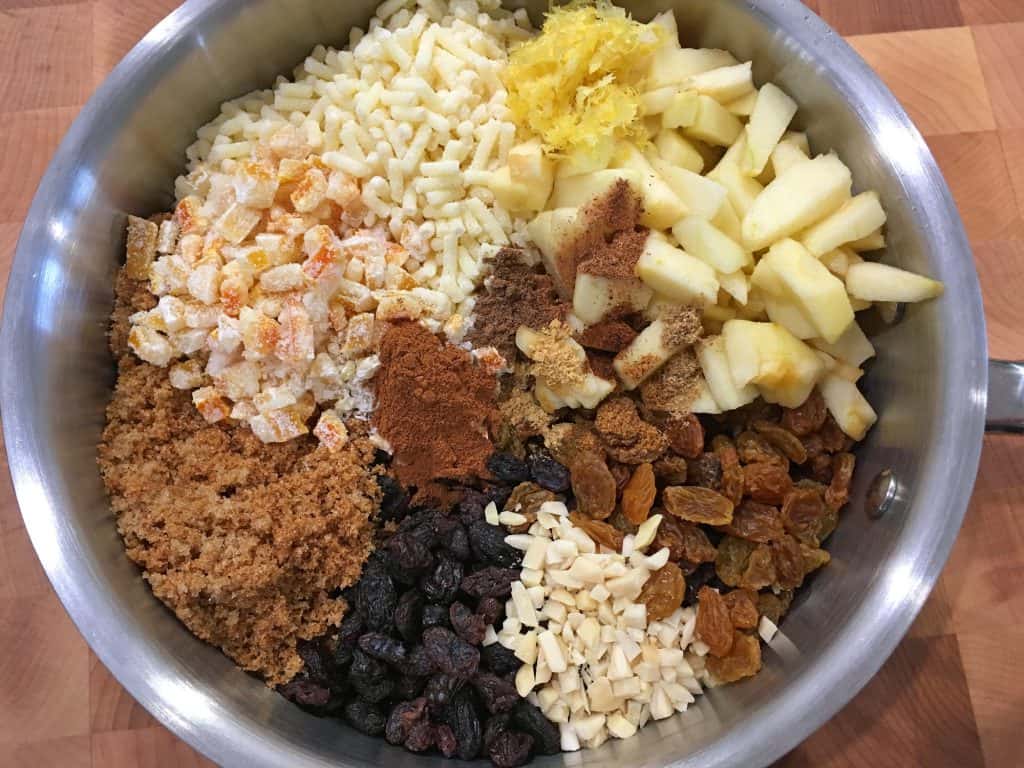
If you’re adding meat, which I highly recommend, you’ll add that at the same time.
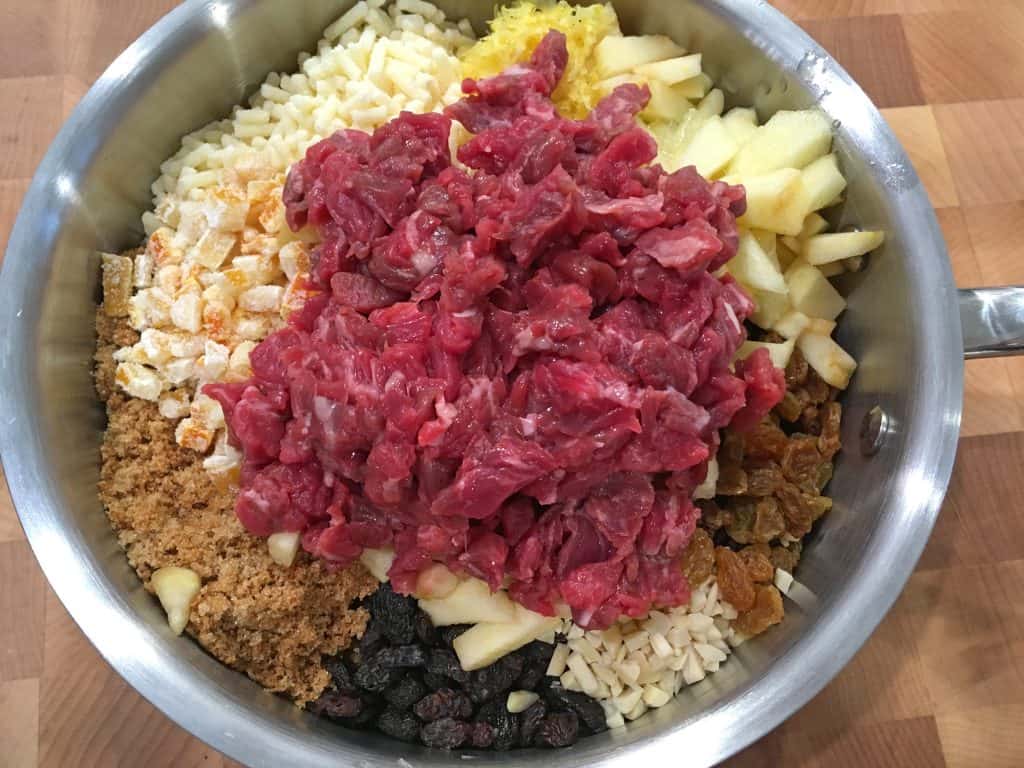
Bring it to a boil and then reduce the heat to LOW and simmer uncovered for about 2 hours, stirring occasionally, more towards the end to prevent burning. If the liquid reduces too soon and the mincemeat starts to stick/scorch on the bottom, add a little bit of apple juice or water.
At the end, stir in the brandy and/or rum. If you prefer to have the alcohol cooked out, add it at the same time as the other ingredients (note, the flavor of the brandy/rum will be less pronounced).
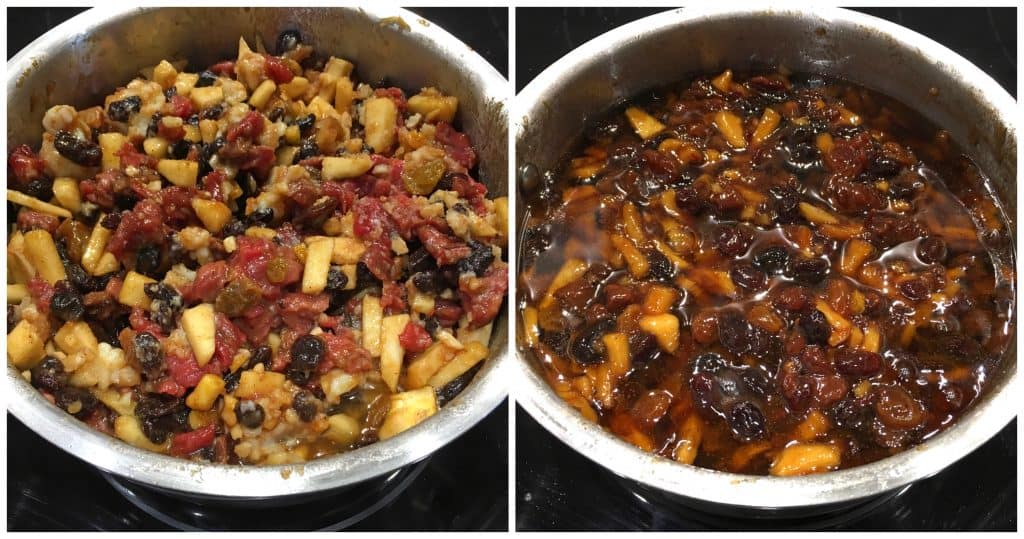
Pour the hot mincemeat into sterilized jars. Let the jars cools.

The liquid suet on top will gradually harden into a protective layer which will enable you to safely store your mincemeat.
**For instructions on different methods for storing your mincemeat, including how to can it for long-term storage, see the blog post section above on Preserving.
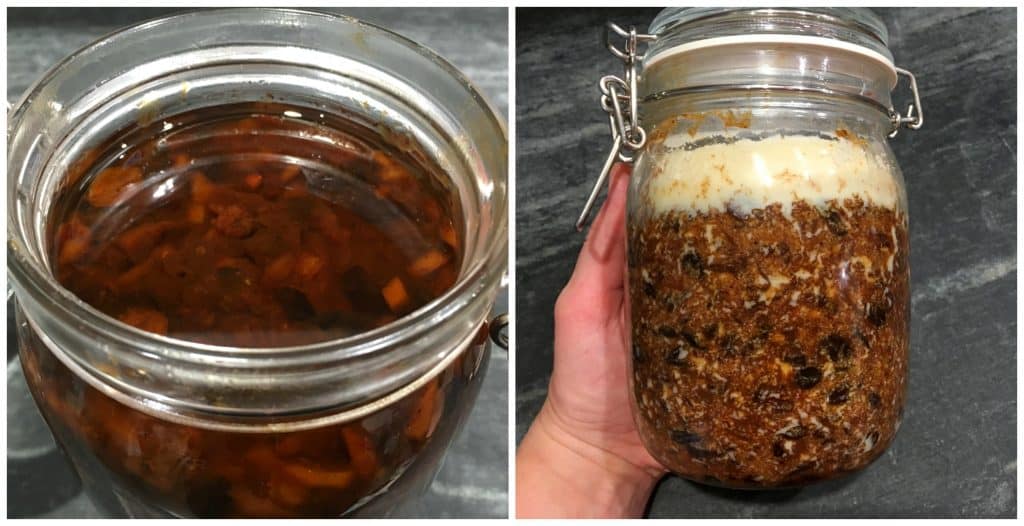
This mincemeat is delicious used immediately but for optimal flavor let it sit in the refrigerator for 1-2 weeks before using. If you’re including the beef in your mincemeat and plan on storing it for longer than a couple of weeks, follow the instructions above for pressure canning your mincemeat.
Now you’re ready to use this mincemeat to make homemade Mince Pies! Or create your own twists by using it for things like mincemeat cake or mincemeat muffins
Enjoy!

For more delicious traditional British treats, be sure to try our:
- Sticky Toffee Pudding
- Lardy Cake
- Eccles Cakes
- Spotted Dick
- Bara Brith
- Barmbrack
- Mince Pies
- Scottish Shortbread
- Yorkshire Parkin
- Flapjacks
- Victoria Sponge Cake
- Crumpets
- Millionaire’s Shortbread
- Yorkshire Pudding
- Figgy Pudding
Save This Recipe
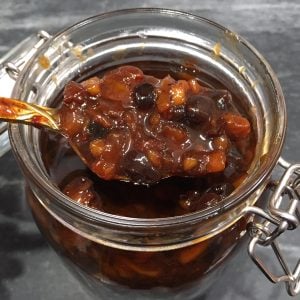
BEST Traditional Mincemeat
Ingredients
- 1 pound (450 grams) finely chopped beef steak , (optional but HIGHLY recommended, otherwise use an extra 1 1/2 cups raisins or currants) **Use a well-marbled cut so it will be tender after the long cooking time; if the cut is lean it will become over-cooked and tough
- Note: Traditionally made with beef or lamb and can also be made with wild game
- 1 1/4 cups (190 grams) raisins
- 1 1/4 cups (190 grams) currants
- 1/2 cup (80 grams) golden raisins
- 2 cups finely chopped tart apple
- 7 ounces (200 grams) shredded beef suet (you can also ask your local butcher for fresh beef suet ground through a fine meat grinder)
- 2 cups (450 grams) packed dark brown sugar
- 2 tablespoons candied lemon peel
- 2 tablespoons candied orange peel
- STRONGLY recommend using Homemade Candied Citrus Peel (click link for recipe)
- 1 1/2 tablespoons (25 grams) finely chopped blanched almonds
- 1 lemon, its zest and juice
- 2 tablespoons apple cider vinegar
- 1 1/2 teaspoons ground cinnamon
- 1/2 teaspoon ground nutmeg
- 1/4 teaspoon ground cloves
- 1/4 teaspoon ground allspice
- 1/4 teaspoon ground mace
- 1/4 teaspoon ground ginger
- 1/4 teaspoon ground coriander
- 2 tablespoons brandy
- 2 tablespoons dark rum
Instructions
- Combine all ingredients except for the brandy and rum in a medium-sized pot and slowly bring to a simmer to prevent scorching. Reduce the heat to LOW and simmer uncovered for about 2 hours, stirring occasionally, more towards the end to prevent burning. (If the liquid reduces too soon and the mincemeat starts to stick/scorch on the bottom, add a little bit of apple juice or water.) Stir in the brandy and rum. (Note: If you prefer to have the alcohol cooked out, add them at the same time as the other ingredients.)
- Spoon the hot mincemeat into sterilized jars (spooning it in the jar while hot will ensure the suet rises to the top to create a layer of fat). As the mixture cools the suet will harden, creating a seal to help preserve the mincemeat. *If you're including the beef be sure to refrigerate the mincemeat. If you're storing it for more than a couple of weeks follow the directions in the blog post for pressure canning the mincemeat for longer-term storage.See blog post for additional ways of storing your mincemeat.
- Makes about 1 quart. Feel free to double, triple, etc, as needed.Use this mincemeat to make homemade Mince Pie (click link for recipe).
- Note: Mincemeat is traditionally stored for several months before using to allow time for the flavors to deepen, however this mincemeat is also delicious eaten within just a few days.
Notes
Nutrition
Originally published on The Daring Gourmet December 16, 2017



















Hi there! I made this mincemeat recipe a couple of weeks ago and stored in the fridge to allow the flavours to develop. I’ve taken it out of the fridge, and it’s gone really hard and gummy and pretty much impossible to spoon out of the jar. I’ve left it at room temp for an hour but it is no where near the consistency of when I first put it in the jar to store. Do you know what I can do to fix it?
Hi Ellie, it sounds like it over-cooked to the point of the sugars heating to soft ball candy stage (which wouldn’t have been apparent while it was warm but only once it fully cooled). It’s still perfectly fine for baking in pies. As for the challenge of scooping it out of the jar, just heat it up briefly in the microwave until it’s scoop-able.
Ahhh okay this explains why, it seemed the right thing texture at the time of cooking but I used a very fancy Kilner preserving pan and I think it did it’s job a little too well! If I warm it up to use in the mince pies, will it not become the same chewy texture one it cools down again? Also thank you so much for your swift reply!
It’s hard to say without trying. It may be that the suet will work it’s way through during baking in such a way that the filling will soften a bit. But it’s also possible that once it’s baked in the pastry shell and you’re chewing the pastry crust along with the mincemeat the chewiness won’t be much of a factor.
Made this recipe last year….froze remaing….used yesterday….most delicious…..as good as and even a little better than my Mother’s from years ago……thank you….will make again
Thank you, Jack, I’m so glad you enjoyed it, but don’t tell your mom it’s better! ;)
I have celiac and the suet you recommend it not gluten free. Do you have any recommendations for substitution?
Hi Peter, you can use fresh suet instead. Most any local butcher should have it. If they don’t have any on hand you can ask them if they have some beef leaf/kidney fat and ask them to run it through the fine meat grinder for you.
It looks like I might have to substitute lard or shortening for the suet, will It influence the flavour too much?
Hi Kimberly, I would would go with lard and that will be totally fine.
I found you, I will be making mincemeat next year. I will start late September- it’s when I do my fruit cake. For the life of me I cannot make pie pastry. But that is all right. It is the mincemeat that I am looking forward to having. – cheers! Wilhelmina
Yikes, I’m running out of time and need help with this recipe! I’m planning to make your very recipe this weekend, in advance of Christmas Eve, but I can’t find any mason jars in shops where I live! I do have some glass jars I’ve saved from other sealed products that the mixture might be able to rest in for 2 weeks, but will this do? I don’t know anything about pressure canning, but if I wash these jars again in the dishwasher, will they be sterilized enough to use? The lids are metal with a small plastic/foam insert on the inside, and were once sealed (I remember popping them open for the original product!). Might I be able to use these again to keep the mincemeat for 2 weeks in the fridge? I hope you might be able to help, it looks like you’ve been responding to questions up to just recently, and I’ve been so excited to try this recipe for the last 2 months! This weekend is IT! :) Thank you so much if you can help!
Hi Kashipan, for pressure canning you’ll need to use canning jars with canning lids – these are specialized lids for that purpose. For safety reasons you cannot use just any jars and especially not just any lids. If you’re just storing your mincemeat in the fridge without pressure canning it you can use any jars and lids you like.
Thank you so much, what a relief! I can’t wait to try this, and I’ll be back to give a proper review! :)
Well, I’m back again this year to try it again, but I wanted to make the mincemeat just short of 2 months early this time….but I’m having a lot of problems trying to figure out about canning this. I really hope you’d be so kind as to help again.
I bought the right kind of jars this time, but realized too late that I don’t have a pressure canner. I kept trying to search up why a water bath wouldn’t work, and every single recipe I find only says “for safety reasons”. What are they, though? Is it because of the layer of fat over the top, if it should come in contact with any water might explode or break the glass? I did further research that said even things with a high fat content in it shouldn’t be canned, whether water bath OR pressure canned because it was dangerous. Never did go into why. I’d considered for a second investing in a pressure canner for this very recipe, but now with all the advice out there not to even pressure can things with a lot of fat, I don’t think I’d risk that.
You mentioned that in old times they used to keep the mincemeat stored away for a year before bringing it out, but how could they do it if the meat was in it? Strictly through pressure canning even back then? I’m pretty confused now. Supposing you sterilize the jar and use the suet to block the air out, then leave the meat mixture in the fridge, will it really go bad after 2 weeks, even though the meat is cooked and it has the suet protection, the alcohol and the cold? I’ve brined raw beef for longer than that and never had a problem with it (I know it’s two different techniques, but that’s raw meat and the mincemeat is cooked with alcohol and fat protecting it. I just wonder why it wouldn’t last in the fridge for even just a week or two longer).
I hope this question doesn’t come off as a snarky, sarcastic challenge – I’m genuinely puzzled and wondering what the safety issues actually are. I think having an answer would help relieve the annoyance of the waste of money I spent buying fancy canning jars I now have no real use for. It’s just a shame, too, to have to wait til December again. I made your recipe last year and loved it enough to make it again this year – so this is definitely not an attack! Just genuinely would love to know why. I was so excited to get started today! Thanks again for responding the first time, too!
Hi Kashipan, I totally get it and those are all good questions. Part of the problem is that not all of the answers are black and white, especially when it comes to how long you can “safely” store something. And so with these kinds of things general guidelines are given and it’s left up to individual discretion. The question about the pressure canner vs. hot water bath: A pressure canner is always used when the pH level of a food is too low (meaning not acidic enough) to prevent the formation of bacteria. That’s one aspect. The other also involves the density of the substance being canned. Jam or diced tomatoes, for example, aren’t nearly as dense as this mincemeat and so the heat of a hot water bath can easily penetrate through the center of things like jams, tomatoes, fruits, etc (which also are naturally acidic enough for water bath canning, including tomatoes when they have a bit of citric acid or lemon juice added to them). Something dense like mincemeat would require very high pressure to thoroughly heat through to the center. Now as to why some people in the old days left their mincemeat sitting out for up to a year…there’s a lot of things people did in the old days I wouldn’t dare do now. But in those particular instances, maybe they didn’t include the meat? I don’t know. I do know that I would absolutely never, ever recommend anyone store it for that long, relying solely on that layer of fat to preserve it. As for what you’re trying to accomplish though, it doesn’t sound like you’re wanting to preserve your mincemeat for several months, it sounds like you’re just wanting to make it a few weeks in advance in time for Christmas, is that right? If that’s the case you have nothing to worry about. The 2 weeks I was referring to was if you’re packing the jars with raw, including raw meat. If your mincemeat is cooked and you’ve got that thick layer of fat on top, you can safely refrigerate it and it will keep for for a few weeks. I’ve personally used it for up to a month. Again, this is a case of individual discretion and judgment. Speaking for myself, if I didn’t already have a pressure canner, I would scrap that idea and just make it up to a few weeks in advance and the use it. I happen to have a pressure canner but I still don’t can this mincemeat. I much prefer to make it “fresh” and it also eliminates any potential risk for something going wrong. And the fact is, this mincemeat is fully AMAZING even after a few days.
Mother of God, this is one of the most delicious things I’ve ever tasted and I’m having difficulty not eating it all straight from the pot (clean spoon each time of course!) It is a world away from shop bought mincemeat, much more rich and aromatic. I made it without beef, used 120g of Kerrygold butter instead of suet and just 200g of dark muscavado sugar and it is plenty sweet and plenty rich. Thank you so much for sharing this fabulous recipe with everyone, it has made by day!
I’m so glad you enjoyed it, Gerry, thank you!
That should have been Fino sherry. It wasn’t that old 😄
Haha, that was a great one, Steve! :)